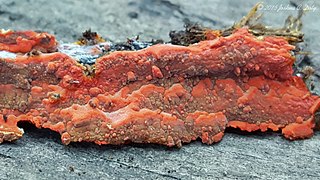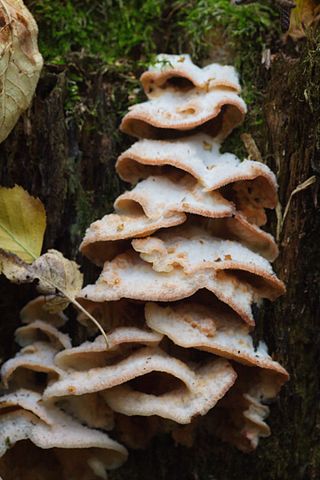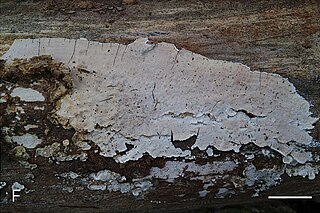
Lewis David de Schweinitz was a German-American botanist and mycologist from Bethlehem, Pennsylvania. Considered the "Father of North American Mycology," he also made significant contributions to botany.
Rhytisma vitis is a species of fungus in the family Rhytismataceae. It was described by Lewis David de Schweinitz in 1832.

Phanerochaete is a genus of crust fungi in the family Phanerochaetaceae.

Geopyxis carbonaria is a species of fungus in the genus Geopyxis, family Pyronemataceae. First described to science in 1805, and given its current name in 1889, the species is commonly known as the charcoal loving elf-cup, dwarf acorn cup, stalked bonfire cup, or pixie cup. The small, goblet-shaped fruitbodies of the fungus are reddish-brown with a whitish fringe and measure up to 2 centimetres across. They have a short, tapered stalk.

Phlebia is a genus of mostly crust fungi in the family Meruliaceae. The genus has a widespread distribution. Phlebia species cause white rot.

Arachnion is a genus of gasteroid fungi in the family Agaricaceae.

Cantharellus lateritius, commonly known as the smooth chanterelle, is a species of edible fungus in the mushroom family Cantharellaceae. The species has a complex taxonomic history, and has undergone several name changes since its first description by American mycologist Lewis David de Schweinitz in 1822. The fruit bodies of the fungus are brightly colored yellow to orange, and usually highly conspicuous against the soil in which they are found. At maturity, the mushroom resembles a filled funnel with the spore-bearing surface along the sloping outer sides. The texture of the fertile undersurface (hymenium) of the caps is a distinguishing characteristic of the species: unlike the well-known golden chanterelle, the hymenium of C. lateritius is much smoother.

Hygrophorus purpurascens, commonly known as the purple-red waxy cap, is a species of agaric fungus in the family Hygrophoraceae. Its cap has a pink background color with streaks of purplish red overlaid, and mature gills have red spots.

Galiella rufa, commonly known as the rubber cup, the rufous rubber cup, or the hairy rubber cup, is a species of fungus in the family Sarcosomataceae. It produces cup-shaped fruit bodies with the texture of tough, gelatinous rubber, with a rough, blackish-brown, felt-like outer surface and a smooth reddish-brown inner surface.

Geastrum minimum, the tiny earthstar, is an inedible species of mushroom belonging to the genus Geastrum. Although rare, it is widespread in Europe, where it occurs in a range of habitats. It is a priority species in the UK, where it has been found in the sand dunes at Holkham National Nature Reserve.

Boletinellus merulioides, commonly known as the ash-tree bolete, is a species of bolete fungus in the family Boletinellaceae. Described as new to science in 1832, it is found in Asia and eastern North America, where it grows on the ground near ash trees.

Lentinus strigosus is a species of fungus in the family Polyporaceae. It is edible when young, but becomes very tough with age.

Multiclavula vernalis or the orange club-mushroom lichen is a species of clavarioid fungus in the Clavulinaceae family. It was originally named as a species of Clavaria in 1822 by Lewis David de Schweinitz. Ronald H. Petersen transferred it to Multiclavula in 1967.
Crustodontia is a fungal genus of uncertain familial placement in the order Polyporales. The genus was circumscribed in 2005 to contain the crust fungus Crustodontia chrysocreas. This species was originally described as Corticium chrysocreas by Miles Berkeley and Moses Ashley Curtis in 1873. Their description was as follows: "Subiculum bright yellow, thin; hymenium immarginate pallid, or yellow tinged with tawny." Crustodontia has a monomitic hyphal system, meaning it contains only generative hyphae, and these hyphae have clamp connections.

Polyporus radicatus is a species of fungus in the family Polyporaceae. It was described as new to science by German-American botanist Lewis David de Schweinitz in 1832. It is found in North America, including Mexico. It grows on the ground, probably from buried roots or originating from sclerotia. Its spores are more or less ellipsoid to spindle shaped, measuring 12–15 by 6–8 μm. It is inedible.

Hydnophlebia omnivora is a species of crust fungus in the family Meruliaceae. It causes white rot in various woody angiosperms, being found in arid regions of the Southern United States, northern Mexico, and Uruguay.

Phlebia coccineofulva, commonly known as the scarlet waxcrust, is a species of crust fungus in the family Meruliaceae. It was described as a new species by Lewis David de Schweinitz in 1832. The fungus is found in North America, continental Europe, and northern Asia, where it grows as a saprophyte on decaying stumps and woody forest debris.

Datroniella scutellata is a species of fungus in the family Polyporaceae, and the type species of genus Datroniella.

Phlebia tremellosa, commonly known as trembling Merulius or jelly rot, is a species of fungus in the family Meruliaceae. It is a common and widely distributed wood-decay fungus that grows on the rotting wood of both hardwood and conifer plants.

Lopharia cinerascens is a species of crust fungus in the family Polyporaceae. It was first described by botanist Lewis David de Schweinitz in 1832 as Thelephora cinerascens. Gordon Herriot Cunningham transferred it to Lopharia in 1956. It is widely distributed in Africa, Asia, Australasia, and North America; it is less common in Europe and South America.


















